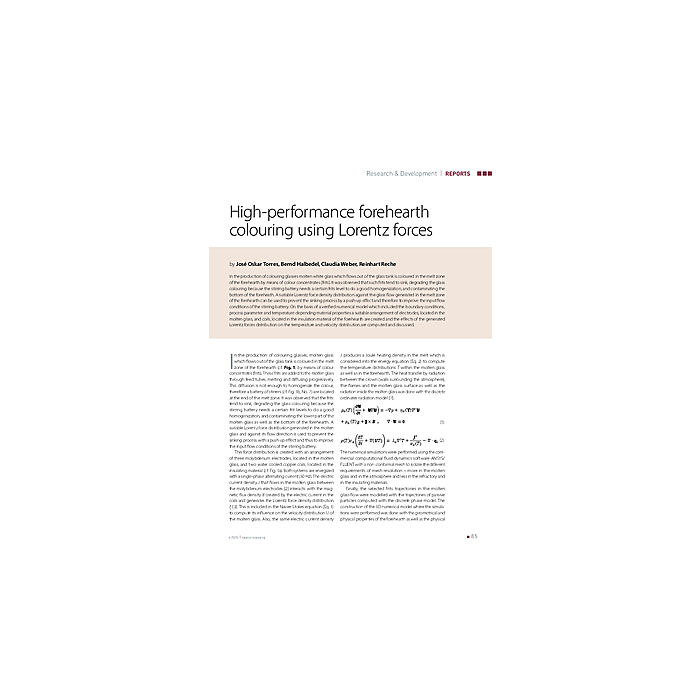High-performance forehearth colouring using Lorentz forces
4,90 €
Auf Lager
Artikelnummer
00541_2015_04_08
In the production of colouring glasses molten white glass which flows out of the glass tank is coloured in the melt zone of the forehearth by means of colour concentrates (frits). It was observed that such frits tend to sink, degrading the glass colouring because the stirring battery needs a certain frits level to do a good homogenization, and contaminating the bottom of the foreheath. A suitable Lorentz force density distribution against the glass flow generated in the melt zone of the forehearth can be used to prevent the sinking process by a push-up effect and therefore to improve the input flow conditions of the stirring battery. On the basis of a verified numerical model which included the boundary conditions, process parameter and temperature depending material properties a suitable arrangement of electrodes, located in the molten glass, and coils, located in the insulation material of the forehearth are created and the effects of the generated Lorentz forces distribution on the temperature and velocity distribution are computed and discussed.
| Autoren | José Oskar Torres / Bernd Halbedel / Claudia Weber / Reinhart Reche |
|---|---|
| Erscheinungsdatum | 01.04.2015 |
| Format | |
| Zeitschrift | heat processing - Ausgabe 04 2015 |
| Verlag | Vulkan-Verlag GmbH |
| Sprache | English |
| Titel | High-performance forehearth colouring using Lorentz forces |
| Beschreibung | In the production of colouring glasses molten white glass which flows out of the glass tank is coloured in the melt zone of the forehearth by means of colour concentrates (frits). It was observed that such frits tend to sink, degrading the glass colouring because the stirring battery needs a certain frits level to do a good homogenization, and contaminating the bottom of the foreheath. A suitable Lorentz force density distribution against the glass flow generated in the melt zone of the forehearth can be used to prevent the sinking process by a push-up effect and therefore to improve the input flow conditions of the stirring battery. On the basis of a verified numerical model which included the boundary conditions, process parameter and temperature depending material properties a suitable arrangement of electrodes, located in the molten glass, and coils, located in the insulation material of the forehearth are created and the effects of the generated Lorentz forces distribution on the temperature and velocity distribution are computed and discussed. |
Eigene Bewertung schreiben


